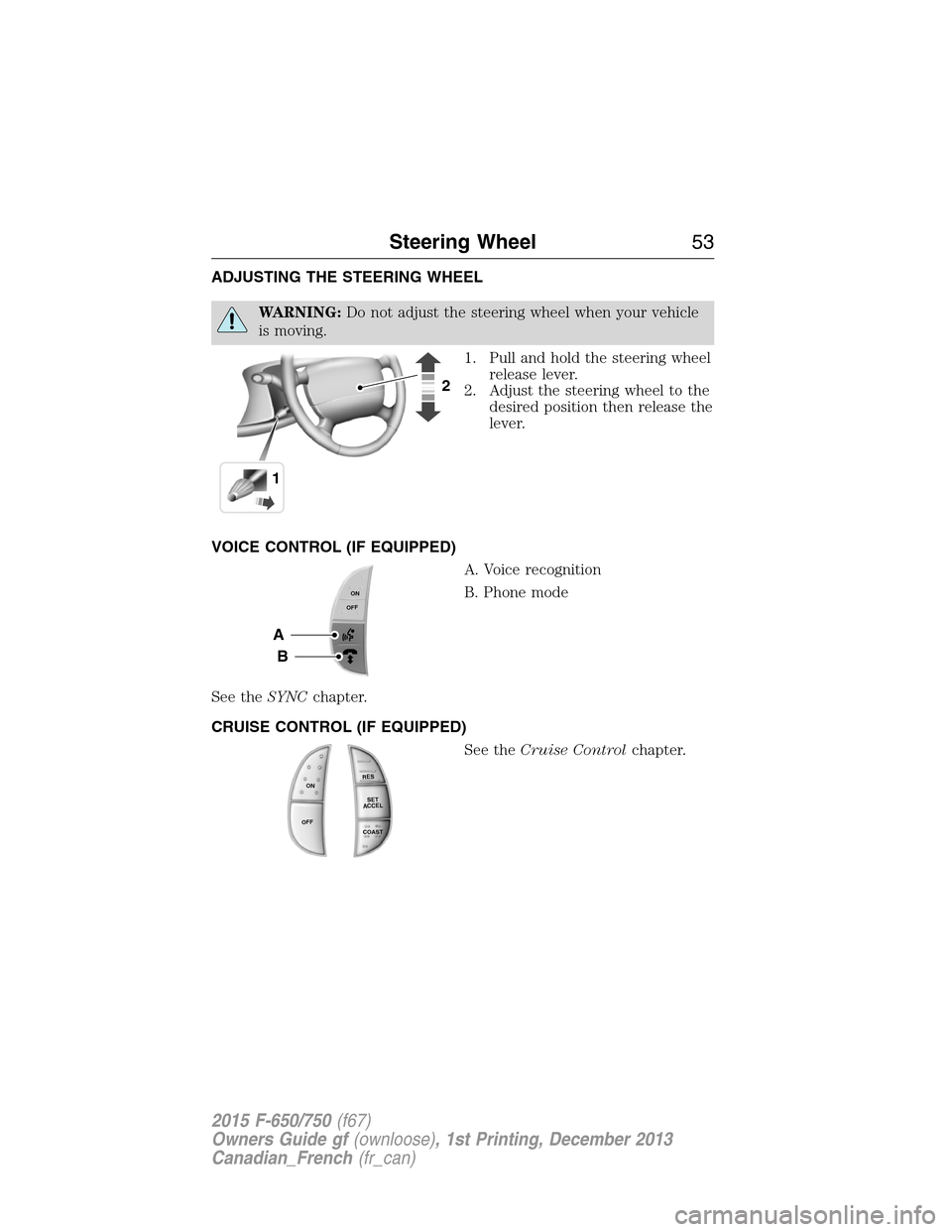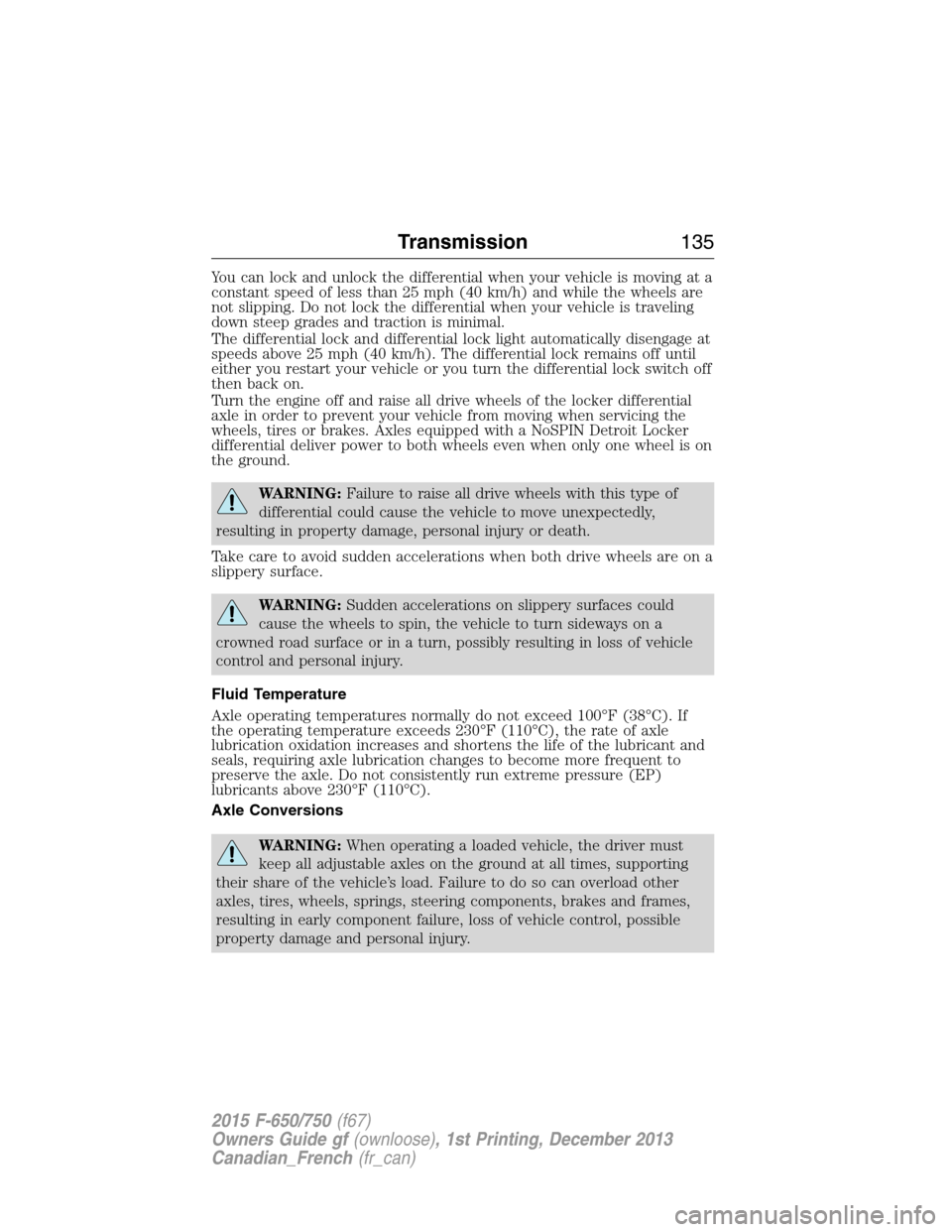2015 FORD F750 steering wheel
[x] Cancel search: steering wheelPage 2 of 384

Introduction 7
Vehicle Inspection Guide 13
Child Safety 23
Child seat positioning...................................25
Booster seats.........................................27
Installing child safety seats...............................30
Child safety locks......................................40
Safety Belts 41
Fastening the safety belts................................42
Safety belt height adjustment.............................47
Safetybeltwarninglightandindicatorchime..................47
Safety belt-minder.....................................48
Child restraint and safety belt maintenance...................50
Keys and Remote Control 51
Keys...............................................51
Locks 52
Locking and unlocking..................................52
Steering Wheel 53
Adjusting the steering wheel..............................53
Steering wheel controls.................................53
Wipers and Washers 54
Windshield wipers.....................................54
Windshield washers....................................54
Lighting 55
Lighting control.......................................55
Instrument lighting dimmer...............................56
Daytime running lamps..................................56
Turn signal control.....................................57
Interior lamps........................................57
Table of Contents1
2015 F-650/750(f67)
Owners Guide gf(ownloose), 1st Printing, December 2013
Canadian_French(fr_can)
Page 14 of 384

VEHICLE INSPECTION INFORMATION
To make sure your vehicle is ready to operate, conduct a pre-trip
inspection at the beginning of each work period. Follow the steps listed
in this section to verify a proper vehicle inspection procedure.
WARNING:Exercise great caution when working on a vehicle
equipped with an automatic fan clutch. The fan starts in motion
only after the engine coolant reaches a predetermined temperature or
the refrigerant pressure (if equipped with air conditioning) reaches a
predetermined setting. The fan starts at this point with no advance
warning. Never reach near, or permit objects to protrude into, the fan
blade radius while the engine is running as this could result in vehicle
damage, personal injury or death.
WARNING:Do not operate the vehicle if any suspension
conditions listed in the following charts are evident. Loss of
steering or suspension could result in property damage, personal injury
or death.
WARNING:If a wheel must be changed, obtain expert tire
service help. Mounting and un-mounting of tires should only be
performed by a qualified technician using necessary safety procedures
and equipment, otherwise the result could be property damage,
personal injury or death.
Note:Always make sure you apply the parking brake before starting the
engine.
Vehicle Inspection Guide13
2015 F-650/750(f67)
Owners Guide gf(ownloose), 1st Printing, December 2013
Canadian_French(fr_can)
Page 17 of 384

Engine starting (with parking brake applied)
Steering linkage
free playInspect for excessive free play in the steering
linkages. The steering wheel should have less
than 2 inches (5 centimeters) of free play at its
rim.
Full power
hydraulic brake
inspectionPump the brake pedal several times with the
ignition in the off or run position. You can
momentarily hear the motor and pumps
replenishing the accumulators.
Parking brakeVerify the parking brake holds the vehicle by
gently trying to pull forward with the parking
brake applied.
Air brakesVerify operation using the following procedure.
Chock the wheels, if necessary. Push in the
parking brake and, on tractors, push in the
tractor parking brake knob:
1. Verify the air compressor or governor cutout
pressure is approximately 120 psi (827 kPa).
2. Turn off the engine, and then turn the key
back to the on position (without starting the
engine).
3. Without the brake pedal applied, note the air
pressure drop for one minute. It should be less
than 2 psi (14 kPa) for single vehicles and 3 psi
(21 kPa) for combination vehicles.
4. Press and hold the brake pedal with 90 psi
(621 kPa) or more. Make sure there is no more
than a 3–psi (21 kPa) per minute leak for single
vehicles and a 4–psi (28 kPa) per minute leak for
combination vehicles.
5. Pump the brake pedal to deplete the system of
air pressure. The warning light and tone should
turn on at 57 psi (393 kPa).
6. Pump the brake pedal and make sure the
parking brake and trailer parking brake knobs
pop out at 20 psi (138 kPa) or higher.
Automatic
transmission fluidVerify that the fluid level is in the proper
operating range. SeeTransmission fluid check
in theMaintenancechapter.
16Vehicle Inspection Guide
2015 F-650/750(f67)
Owners Guide gf(ownloose), 1st Printing, December 2013
Canadian_French(fr_can)
Page 54 of 384

ADJUSTING THE STEERING WHEEL
WARNING:Do not adjust the steering wheel when your vehicle
is moving.
1. Pull and hold the steering wheel
release lever.
2. Adjust the steering wheel to the
desired position then release the
lever.
VOICE CONTROL (IF EQUIPPED)
A. Voice recognition
B. Phone mode
See theSYNCchapter.
CRUISE CONTROL (IF EQUIPPED)
See theCruise Controlchapter.
12
A
B
ONOFF
R
E
S
S
E
T
A
C
C
E
L
C
OA
S
T
ON
OFF
Steering Wheel53
2015 F-650/750(f67)
Owners Guide gf(ownloose), 1st Printing, December 2013
Canadian_French(fr_can)
Page 74 of 384

GENERAL INFORMATION
WARNING:Driving while distracted can result in loss of vehicle
control, crash and injury. We strongly recommend that you use
extreme caution when using any device that may take your focus off
the road. Your primary responsibility is the safe operation of your
vehicle. We recommend against the use of any hand-held device while
driving and encourage the use of voice-operated systems when possible.
Make sure you are aware of all applicable local laws that may affect the
use of electronic devices while driving.
You can control various systems on your vehicle using the information
display controls on the steering wheel. Corresponding information
appears in the information display.
Information Display Controls
•Press the INFO button to scroll
through trip and fuel usage
information.
•Press the SETUP button to
scroll through various vehicle
feature settings.
•Press the RESET button to
choose settings, reset
information and confirm
messages.
Info
Press the INFO button repeatedly to cycle through the following
features:
Note:Some options may appear slightly different or not at all if the
items are optional.
INFO
TRIP A/B
MILES (km) TO E
AVG MPG (L/100 km)
TIMER
BLANK SCREEN
INFOSETUP
RESET
Information Displays73
2015 F-650/750(f67)
Owners Guide gf(ownloose), 1st Printing, December 2013
Canadian_French(fr_can)
Page 80 of 384

SITTING IN THE CORRECT POSITION
WARNING:Do not recline the seat back as this can cause the
occupant to slide under the seat’s safety belt, resulting in severe
personal injury in the event of a crash.
WARNING:Do not place objects higher than the seat backs to
reduce the risk of injury in a crash or during heavy braking or
when stopping suddenly.
When you use them properly, the
seat, head restraint and safety belt
provide optimum protection in the
event of a crash. We recommend
that you follow these guidelines:
•Do not recline the seat back more than 30 degrees from vertical.
•Sit in an upright position with the base of your spine as far back as
possible.
•Adjust the head restraint so that the top of it is level with the top of
your head and as far forward as possible, remaining comfortable.
•Keep sufficient distance between yourself and the steering wheel. We
recommend a minimum of 10 inches (250 millimeters) between your
breastbone and the center of the steering wheel.
•Hold the steering wheel with your arms slightly bent.
•Bend your legs slightly so that you can press the pedals fully.
•Position the shoulder strap of the safety belt over the center of your
shoulder and position the lap strap tightly across your hips.
Make sure that your driving position is comfortable and that you can
maintain full control of your vehicle.
Seats79
2015 F-650/750(f67)
Owners Guide gf(ownloose), 1st Printing, December 2013
Canadian_French(fr_can)
Page 129 of 384

If the fuse is not blown and the brake lamps are working properly, the
following procedure allows you to move the gearshift lever from position
P:
1. Apply the parking brake, and
turn the engine off.
2. Remove the lower finish panel
below the steering column.
3. Turn the key to the on position,
but do not start the engine.
4. Pull back on the solenoid, and
at the same time, shift the
transmission into positionN.
5. Start your vehicle.
See an authorized dealer as soon as
possible if this procedure is used.
Six–speed TorqShift® Transmission
WARNING:Always set the parking brake fully and make sure
the gearshift is latched in position P. Turn the ignition to the off
position and remove the key whenever you leave your vehicle.
WARNING:Do not use the tow/haul feature when driving in icy
or slippery conditions as the increased engine braking can cause
the rear wheels to slide and the vehicle to swing around with the
possible loss of vehicle control.
128Transmission
2015 F-650/750(f67)
Owners Guide gf(ownloose), 1st Printing, December 2013
Canadian_French(fr_can)
Page 136 of 384

You can lock and unlock the differential when your vehicle is moving at a
constant speed of less than 25 mph (40 km/h) and while the wheels are
not slipping. Do not lock the differential when your vehicle is traveling
down steep grades and traction is minimal.
The differential lock and differential lock light automatically disengage at
speeds above 25 mph (40 km/h). The differential lock remains off until
either you restart your vehicle or you turn the differential lock switch off
then back on.
Turn the engine off and raise all drive wheels of the locker differential
axle in order to prevent your vehicle from moving when servicing the
wheels, tires or brakes. Axles equipped with a NoSPIN Detroit Locker
differential deliver power to both wheels even when only one wheel is on
the ground.
WARNING:Failure to raise all drive wheels with this type of
differential could cause the vehicle to move unexpectedly,
resulting in property damage, personal injury or death.
Take care to avoid sudden accelerations when both drive wheels are on a
slippery surface.
WARNING:Sudden accelerations on slippery surfaces could
cause the wheels to spin, the vehicle to turn sideways on a
crowned road surface or in a turn, possibly resulting in loss of vehicle
control and personal injury.
Fluid Temperature
Axle operating temperatures normally do not exceed 100°F (38°C). If
the operating temperature exceeds 230°F (110°C), the rate of axle
lubrication oxidation increases and shortens the life of the lubricant and
seals, requiring axle lubrication changes to become more frequent to
preserve the axle. Do not consistently run extreme pressure (EP)
lubricants above 230°F (110°C).
Axle Conversions
WARNING:When operating a loaded vehicle, the driver must
keep all adjustable axles on the ground at all times, supporting
their share of the vehicle’s load. Failure to do so can overload other
axles, tires, wheels, springs, steering components, brakes and frames,
resulting in early component failure, loss of vehicle control, possible
property damage and personal injury.
Transmission135
2015 F-650/750(f67)
Owners Guide gf(ownloose), 1st Printing, December 2013
Canadian_French(fr_can)